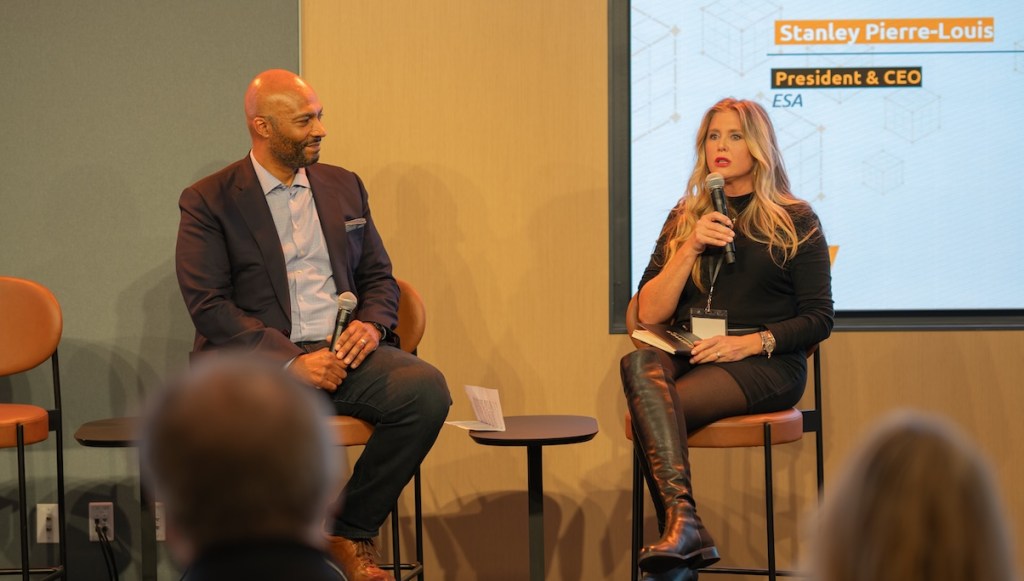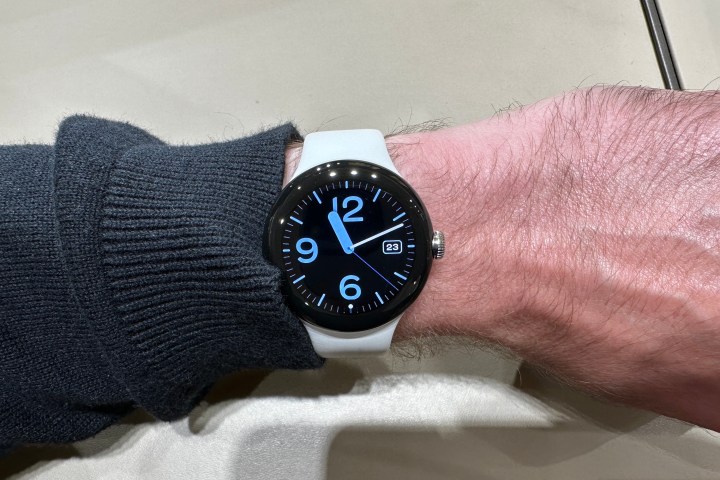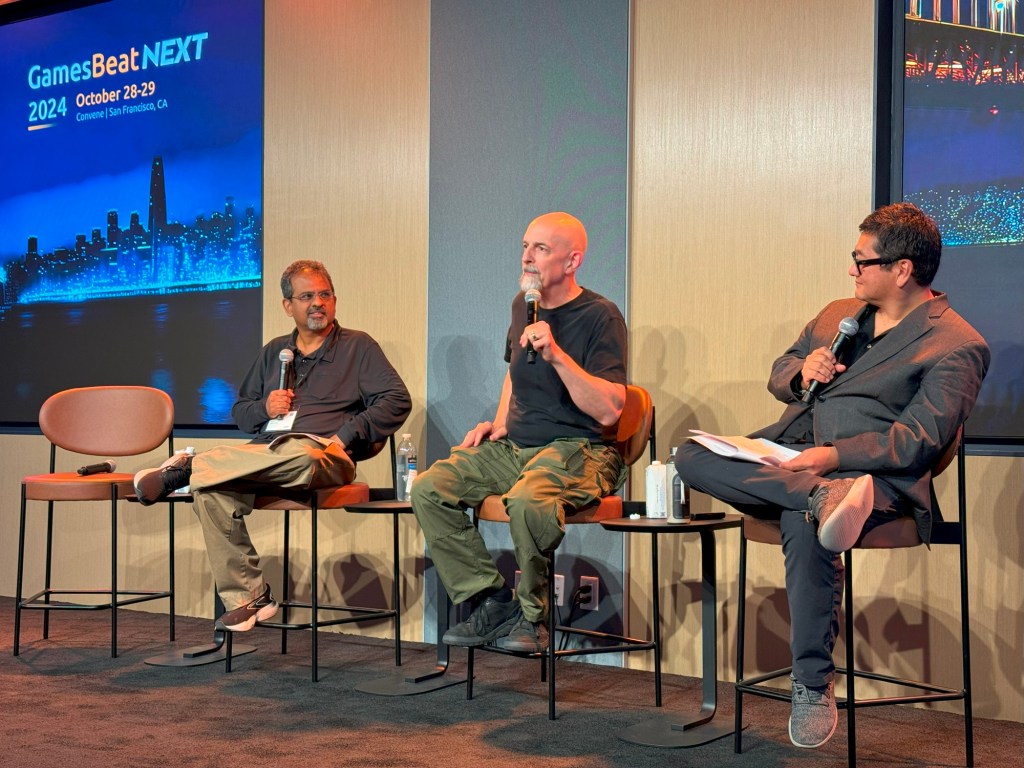Technology
Amazon Games talks IP growth opportunities across five generations of gamers

The goal of Amazon Games, the game publishing and development arm of Amazon, is to become a world-class top publisher in the game industry, says Laura Naviaux Sturr, GM, Operations, Amazon Games. The studio has launched three chart-topping titles so far: New World, Lost Ark, and Throne and Liberty.
At GameBeat Next, Naviaux Sturr spoke with Stanley Pierre-Louis, president and CEO, Entertainment Software Association (ESA), about the studio’s future portfolio and the ways its investments will come to bear over the next three years. That includes titles like the upcoming action brawler King of Meat and a new collaboration with Maverick Games on a future narrative-led, open-world driving adventure game, and big-swing investments in IP like Tomb Raider and The Lord of the Rings — and looking for breakout opportunities.
“The industry is at an inflection point right now,” she said. “We want to take two to three big bets a year and figure out the ones we can dial up a few notches. In our portfolio strategy, we need the blue chips with the dividends, some growth opportunities and engines and then taking some fun experimental bets. If you fast forward 10 years from now, what is Gen Alpha and Gen Z expecting from their gameplay experiences?”
Generating growth through IP
Media giants like Warner, Disney, and even Netflix are seeing great success exploiting their IP across media streams, and that’s a big part of the Amazon Games’ strategy. They’re all growing IP to take to transmedia, as well as leap at opportunities to secure established IP.
“Big IP will always matter, always carry with it this extraordinary fandom,” Naviaux Sturr said. “The big ones in the video game world are trying to get that commentary out of the depths of the internet into real-life experiences or through film and television or theme parks, like what you see with some of the very biggest video game IP. That’s an interesting vector in terms of finding new growth.”
For nascent video game IP, careful planning is crucial during the creation process, such as giving secondary characters potential for their own stories, considering what a prequel might entail, making sure the story could move throughout the timeline of your world in a compelling way and more.
“It’s more of the franchise planning at the outset that I’m seeing developers be very smart and strategic about. Look at how IP is being invented from the corners of the internet,” she said. “You have the Alexa Fund as an early investment vehicle at Amazon. We invested in a company called Superplastic. Their whole thesis was, how do we take Unreal and this ubiquitous technology that presumably will become very common, a skill set that a lot of developers have, and invent IP through social media?”
Demographics, attitudes and IP
In this year’s ESA study, “Essential Facts About the U.S. Video Game Industry,” they looked at Gen Alpha’s playing dynamics for the first time, and found that 79% percent play video games, with Gen Z’s numbers not far behind at 76% — a massive addressable market of people who love games. The average age of gamers is increasing over time, suggesting that more and more folks are lifelong gamers, playing not only new titles, but the titles they grew up with. Bringing those consumers along the journey of an IP they love requires some strategy, Naviaux Sturr says, which depends on the maturity of the franchise, consumer expectations and what the fans want.
With early-stage IP, there’s a lot more flexibility in the ways that you can expand and grow. But big IP holders like Roblox and Amazon Games, which see players across generations, have hard decisions ahead of them about how much player agency you’re going to allow this generation to have with your IP.
“In these user-generated worlds, micro-communities playing with a few people, watch parties — they expect to be able to have different rule sets and modify the game and do that in a way that feels very modern, seamless and easy,” she said. “For most of them, the common denominators are that they’re online, they play highly social experiences, and typically competitive ones, and some form of PvP (player vs. player). It’s my personal belief that this will still be their expectation 10, 20, 30 years from now.”
But she points at other statistics like the 53% of gamers who want single-player experiences. Addressing those consumers will require developers to challenge conventions: does every single-player game have to be 30 hours long, or have a single ending, and so on, and what will these games look like in the future?
“Our capital is always in terms of long-term value creation,” Naviaux Sturr said. “We’re taking that long view in making these stories, characters and narratives, and allowing them to come into these various spaces, whether through transmedia or the game itself, and telling new stories that wouldn’t have been possible otherwise.”
Technology
AI helps robot dogs navigate the real world
Four-legged robot dogs learned to perform new tricks by practising in a virtual platform that mimics real-world obstacles – a possible shortcut for training robots faster and more accurately
Science & Environment
Jack Dorsey dramatically shutters Block’s TBD crypto unit

Jack Dorsey, co-founder of Twitter Inc., speaks during the Bitcoin 2021 conference in Miami, Florida, U.S., on Friday, June 4, 2021.
Eva Marie Uzcategui | Bloomberg | Getty Images
During the crypto-crazed summer of 2021, when memecoins like dogecoin and Shiba Inu were rocketing alongside bitcoin and ethereum, Square founder Jack Dorsey announced that his payments company was starting a new business unit, with the goal of “making it easy to create non-custodial, permissionless, and decentralized financial services.”
“Our primary focus is #Bitcoin,” Dorsey proclaimed on Twitter. The name of the business unit would be TBD.
In December of that year, Dorsey went a step further, changing the name of Square Inc. to Block, a reference, he said, to a number of things, including blockchain, the technology underpinning bitcoin. The Square Crypto business became known as Spiral.
Three years later, Dorsey is in retreat.
On Block‘s third-quarter earnings call on Thursday, CFO Amrita Ahuja said Block has “made some recent decisions with respect to some of our emerging initiatives” and is “winding down our TBD efforts.”
Block continues to own a hefty amount of bitcoin on its balance sheet, with the current value of its holdings swelling to $630 million. And the company said it will be investing in a bitcoin mining initiative as well as Bitkey, its bitcoin wallet, while continuing to allow users to buy bitcoin through Cash App.
It’s a notable change of tune.
TBD was designed to be Block’s platform for developers. Block called it Web5 and said the mission was to create a more decentralized, secure and private internet. Dorsey said in a tweet in mid-2022 that Web5 “will likely be our most important contribution to the internet.”

Square’s five-year stock chart
But Wall Street’s view on crypto was starting to sour dramatically. With inflation soaring in 2022 and interest rates on the rise, shareholders demanded quicker returns on their investments. After peaking in 2021, Block shares lost more than 80% of their value before bottoming in October of last year.
Block said in late 2023 that it would cut its headcount — then about 13,000 staffers — by as much as 1,000 by the end of 2024. Fortune reported that Block laid off employees at TBD in recent weeks. And in the third-quarter shareholder letter, Block said it was “scaling back” its investment in Tidal, the music-streaming service founded by Jay-Z, after spending about $300 million on a majority stake in the business in 2021. Tidal was part of TBD.
Dorsey was asked by an analyst on Thursday’s call about the company’s current bitcoin strategy.
“What we’re focused on in terms of our strategy overall on bitcoin is making it more accessible, making sure that more people can access bitcoin, buy, sell it, obviously, but also send it peer-to-peer,” Dorsey said.
Dorsey added that he wants “the internet to have a native currency,” because that would allow Block to move money faster and offer Cash App and other products in more markets.
A Block spokesperson reiterated the company’s public statement and pointed to Dorsey’s comments from the earnings call.
What’s become clear is that Dorsey can only do so much with crypto while trying to appease a more discerning Wall Street. Shares of Block were down about 1% at market close on Friday, after the company reported revenue that trailed estimates and issued weaker gross profit guidance than some analysts were expecting.
In his 1,400-word letter to shareholders, Dorsey focused entirely on the company’s lending offerings for small businesses. A significant chunk of that is the buy now, pay later product from Afterpay, which Block acquired for $29 billion in 2021.
Dorsey didn’t mention crypto or bitcoin once.

Technology
Best Smartwatch Deals: Samsung, Google, Apple, and Garmin

You can almost always count on a smartwatch for some impressive savings, as even the best smartwatches regularly see a discount. The best Apple Watch deals often lead the charge when it comes to smartwatch discounts, but Google Pixel watch deals and Samsung Galaxy Watch deals aren’t far behind. Fitbit deals almost always come in with great starting price points as well. There are a lot of smartwatch deals taking place right now, and to remove any confusion we’ve rounded up the best smartwatch deals below. Reading onward you’ll find great smartwatch savings whether you’re shopping for style or for one of the best fitness trackers.
Google Pixel Watch — $175 $280 37%

If you’re searching for a new smartwatch and you already own a Google Pixel phone, you might as well grab the Google Pixel Watch. The two obviously make a good pair. The Pixel Watch lets you access your messages and calendar, and even lets you control your other Google smart devices. That means changing the temperature, picking a TV show, or turning on lights just by talking into your wrist. It works with most Android phones, and comes with fitness tracking for 40 different exercises.
Garmin Venu Sq — $180 $200 10% off

The Garmin Venu Sq smartwatch is a great option for anyone in search of a smartwatch that crosses over between a fitness device and a fashion accessory. It features the broadest range of all-day health monitoring features, which include things like energy level monitoring, respiration and stress tracking, and sleep tracking. You can easily download songs to the Garmin Venu, including playlists from Spotify, Amazon Music or Deezer, as well as other third-party music providers. The Garmin Venu makes great accompaniment when you’re deep into a workout, and its classy, luxurious design looks great when you’re out on the town.
Apple Watch SE 2 — $189 $249 24% off

The Apple Watch SE 2 is the second iteration of Apple’s entry-level smartwatch. It rivals some higher end models in terms of capability, and includes all of the tracking and fitness features the Apple software ecosystem is famous for. This includes features like crash detection, fall detection, and emergency SOS, as well as fitness monitoring and health tracking software. It works seamlessly with your Apple devices and services, and can unlock your Mac automatically, help you find your devices with a tap, pay and send money with Apple Pay, and give you access to thousands of apps on the App Store.
Samsung Galaxy Watch 6 Classic — $198 $227 13%

The Samsung Galaxy Watch 6 Classic is the premium version of the Samsung Galaxy Watch 6. While both models share health and fitness tracking capabilities, the Samsung Galaxy Watch 6 Classic looks more like a traditional watch with its stainless steel case compared to the sporty look of the Samsung Galaxy Watch 6, and it also keeps the rotating bezel that you’ll use to navigate its interface. Our Samsung Galaxy Watch 6 Classic versus Samsung Galaxy Watch 6 comparison highlights more differences, so feel free to check it out.
Samsung Galaxy Watch 5 Pro (45mm) — $238 $500 52% off

The Samsung Galaxy Watch 5 Pro has been on the market for a couple of years, but it still holds well as smartwatches go. Key features include advanced sleep coaching, start of the art accuracy, wellness readings, and the ability to track a variety of outdoor adventures. The Samsung Galaxy Watch 5 lineup in general currently makes for some of the best smartwatch deals you’ll find. This Galaxy Watch 5 Pro model offers great value at this price, as it’s still a relatively new smartwatch.
Apple Watch Series 9 (GPS, 45mm) — $599 $749 20%off

The Apple Watch Series 9 is the best smartwatch for the iPhone, according to our roundup of the best smartwatches, with its extensive health, fitness, and safety features combined with fast and smooth performance. You also wouldn’t want any other wearable device with your iPhone because it’s very easy to pair it with the Apple Watch Series 9. You won’t mind wearing the smartwatch the whole day because it’s extremely comfortable on your wrist, and Apple’s S9 chip enables new capabilities such as processing Siri commands locally on the Apple Watch Series 9.
More smartwatch deals we love

If none of the smartwatch deals above excite you, check out the other amazing offers that we’ve come across. There’s something for everyone, ranging from cheaper previous-generation models to premium wearable devices, so at least one of these bargains should catch your eye. Once that happens, you’re going to have to proceed with the transaction as soon as possible because we’re not sure how much time is remaining on these discounts.
- — $110
$15027% off - — $153
$20024% off - — $180
$25028% off - — $200
$35043% off
How we chose the best smartwatch deals
There are a lot of smartwatches on the market, and while that can make finding a smartwatch deals pretty easy, it can make narrowing the best smartwatch deals down a little more difficult. Top brands like Garmin, Apple, Google, and Samsung pretty much always have numerous smartwatch models discounted across retailers. Big brands like these are, of course, the most popular among shoppers, so we make a point of including at least one model from each of these in our selections for the best smartwatch deals.
Smartwatches, really, are some of the most discounted pieces of tech you can find out there. Those top brands mentioned above generally keep older generations of their smartwatches on the market alongside their new releases, and that opens up all sorts of room for smartwatch deals. Smartwatches such as the Apple Watch SE, Apple Watch Series 8, Samsung Galaxy Watch 5, and numerous Fitbit models are at least a generation old and the perfect candidates to see some major discounts. They’re also regulars among the best smartwatch deals.
And while pricing and availability are the two most important factors when we choose the best smartwatch deals, style is something we consider as well. Some people are looking for a smartwatch to look good, while others are in the market for something to help with their fitness routine. Brands recognize this and tailor certain smartwatch models to each. When we make our selections for the best smartwatch deals we try to keep a nice balance between the two and provide a number of discounted smartwatches for different tastes.
Technology
YouTube Premium’s grandfathered $7.99 price to disappear soon

It looks like early subscribers to the now-known as “YouTube Premium” plan will soon lose the lower price compared to those who came later. As a way of rewarding its first paid users, Google did not increase the cost of the service for several years. However, everyone will soon lose access to YouTube Premium’s grandfathered price, starting in Europe.
YouTube Premium’s grandfathered (early adopter) price will increase after several years
YouTube’s first premium subscription arrived in 2014 under the name “Music Key.” The plan started at a price of $7.99 during a trial period where a limited number of people could sign up. Later, the company raised it to $9.99. Those who were paying $9.99 had already received a price increase last year. Now, those users who were still enjoying the grandfathered price of $7.99 could receive the same treatment.
According to reports, YouTube users in European countries are receiving a notification about the upcoming change in the price of the Premium plan. The increase will not take effect immediately, as the company will give three more months at the original rate to early subscribers of the service. Once the deadline passes, they will have to start paying the same price as everyone else in the region.
Currently, the YouTube Premium plan has a $13.99 price tag in the US. When YouTube will implement the same measure in the US and other regions is unknown.

The price of $7.99 has remained fixed since 2014
The video platform’s paid plan has gone through multiple changes since its inception. In 2018, the Mountain View giant relaunched YouTube Music as the successor to Music Key for a better music streaming experience. At that time, “beta subscribers” not only kept the same price but also enjoyed all the benefits of YouTube Premium (including ad-free videos) for the initial $7.99 or $9.99. For reference, that year, YouTube Premium and YouTube Music Premium cost $11.99 and $9.99, respectively.
Years later, in 2023, Google implemented a $2 increase in the price of the plans. Since then, YouTube Music Premium and YouTube Premium have cost $11.99 and $13.99, respectively. Even then, the company kept the price intact for its beta subscribers who paid $7.99. However, those who paid $9.99 already had to start paying the new prices.
Now, the platform’s next move is to eliminate the $7.99 grandfathered price as well. Those lucky enough to still enjoy it will have three months to continue doing so and decide whether to keep the plan at the new cost or stop paying it.
Technology
Awesome Games Done Quick 2025 will include Crazy Taxi with a live backing band

It’s almost time again for Awesome Games Done Quick (AGDQ), the zany speedrun-fest for a good cause. The hook for this year’s event is a run of the Dreamcast classic Crazy Taxi with a live backing band. Funds raised from this year’s showcase will benefit the nonprofit Prevent Cancer Foundation. AGDQ 2025 runs from January 5 to 12 in Pittsburgh.
The live instrumental band rocking out during a Crazy Taxi run sounds like a fun centerpiece. You can check out a preview in the video below, which showed the same band rocking out to a recorded run of the game at Summer Games Done Quick (SGDC) 2024. On Saturday, January 11 at 4:48PM ET, you can catch a fully live version.
Other highlights on the agenda include a run of the instant PlayStation classic Astro Bot on Sunday, January 5 at 6:30PM ET, a speedrun of Pokémon Omega Ruby/Alpha Sapphire for 3DS on January 11 at 8:18AM ET and a play-through of the Wii port of The Legend of Zelda: Ocarina of Time on the same day at 4PM ET. You can check out the full schedule for more.
Last year’s AGDQ (also in Pittsburgh) raised $2.5 million for the Prevent Cancer Foundation. Among its best bits were a no-hit run of Resident Evil 2 (2019), Super Mario 64 completed on an electric drum kit and a pup named Peanut Butter lending a paw to help his person beat the NES classic Gyromite. The Games Done Quick Organization has raised $51.8 million for various charities throughout its 15 years.
You can stream AGDQ 2025 on Twitch. Or, if you want to attend live at the Wyndham Grand in downtown Pittsburgh, you can register now.
Technology
Snow Crash author Neal Stephenson on the ‘metaverse stock price’ | The DeanBeat

We got a sense recently for the “metaverse stock price” as it stands in 2024 at our recent GamesBeat Next 2024 event.
Neal Stephenson talked about that notion as he did a talk about how to make sci-fi come true and turn the dreams for an open metaverse into reality. Stephenson famously coined the word “metaverse” in his novel Snow Crash that debuted in 1992. I read the novel back then and I was honored to co-moderate a fireside chat with Stephenson at our recent GamesBeat Next 2024 event.
Riz Virk, author of the Simulation Hypothesis, which is about whether we’re living in a simulation, joined me as co-moderator. I’m pretty sure our talk with Stephenson was real, and that Virk is also a faculty associate at Arizona State University, founder of Play Labs, and venture partner at Griffin Gaming Partners.
Stephenson has written many science fiction novels, but he joined us in a session entitled “The science fiction future that we want.” And he is dedicated to turning some of his ideas, like the metaverse, into science fact. He is cofounder of Whenere, which is making a game where users can use AI to enhance their storytelling. Whenere is what creators would use to create linear narratives. And Stephenson is also cofounder of Lamina1, a Web3 company focused on fair compensation for digital creators.
We started out with his definition of the metaverse, which for him has a spatial element, and then we strayed into discussions of the “metaverse stock price” and whether games like Fortnite, Minecraft and Roblox count as metaverse applications.
We also discussed Whenere’s attempt to let users create their own stories, first around Jane Austen’s Pride & Prejudice universe (which is no longer copyrighted). Interestingly, Stevenson said he doesn’t use AI to write because he “knows how to write.”
Asked about the kind of science fiction future he wants, he said he is concerned about “carbon” and the fact that so many people don’t know what is real. (Given recent events, I can relate to the latter one). We even talked about digital twins and the notion that the metaverse might be inside Microsoft Flight Simulation 2024. We quizzed him about his newest novel Polostan, about the pre-atomic bomb era, and whether it has parallels to our era ahead of general artificial intelligence. And we asked if there would be a Snow Crash 2 or a Snow Crash film.
Here’s an edited transcript of our fireside chat with Stephenson. You can also watch the video in this post.

Riz Virk: Neal, you were talking recently about Matthew Ball and Tim Sweeney. You offered a definition of the metaverse: a massively multiplayer online universe that has a sense of space, where there are experiences distributed around that space in a way that’s perceived by all of its users in the same way. You can move from one place to another and interact with other users who are not physically present. It’s not controlled by any one entity. Many creators large and small build things there.
Stephenson: That was me being somewhat off the cuff, but when you read it back, it covers most of the important bases of what we want from a metaverse.
GamesBeat: I noted that the word metaverse on Google trends saw its peak in 2021, after Mark Zuckerberg changed his company’s name to Meta. The word has had a slight comeback, but it’s nowhere near as popular as it was during the pandemic. What observation would you have on this?
Stephenson: Tim Sweeney, in that conversation you mentioned, which is a pretty interesting document – you can find it on Matt Ball’s website – he likened it to a stock whose value goes up and down. But it’s always there at some level. If somebody does something cool that’s connected with the idea of the metaverse then the stock rises. If somebody does something lame the value goes down. But the ups and downs are against the context that it’s an ongoing project. It doesn’t necessarily cease to exist just because it’s gone into a down phase.
GamesBeat: Fortnite, Roblox, Minecraft happened and the stock goes up. But if something in the market doesn’t pan out, it’s going down.
Stephenson: To the extent that people think–it’s clear, unequivocally, that Tim thinks of the three applications you mentioned as absolutely being metaverse applications. By that standard, there are many hundreds of millions of people using it all the time and it’s making money. If you have a different definition of what the metaverse is, if you think of it as exactly what’s described in the novel, then it’s still a little ways out.

Virk: Snow Crash had the idea of programs like the Librarian and other AI characters within the metaverse. Sometimes I like to joke that the AI in the metaverse are the real residents. The rest of us just visit as avatars. I’m curious about this recent trend of smart NPCs. Companies like Inworld and Replika are creating these NPCs that are basically light wrappers around LLMs like ChatGPT. What are you thoughts about how AI will evolve in the metaverse?
Stephenson: That’s one we’re working on with Whenere, which is the product that (emcee) Tadhg (Kelly) just alluded to. We started experimenting with Inworld’s AI technology at the beginning of 2023. We whipped up a demo, a character called Virj from the Snow Crash universe, who we created in Unreal Engine using the Inworld AI platform. We were impressed by it. It was fascinating, which is how we got going on our current project. We’re very much paying attention to that and using those tools in an intensive manner every day. We think there’s huge potential there, which is why we’re doing it.
GamesBeat: You have some more things going on at Whenere, like the Jane Austen novel, this marriage of AI and storytelling.
Stephenson: Like I said, the first thing we tried was this character from Snow Crash. On further reflection, one of my co-founders came up with the idea of instead starting with the world of Pride and Prejudice, for several reasons. One is that we love it, but beyond just that, it’s in the public domain. We don’t have to spend the first year fucking around with lawyers. It’s conversation-based. There’s no starship battles or gunfights or other things that are hard and expensive to bring to life in a game engine. It’s people sitting in rooms talking to each other. We thought it was a good test case to prove the point that we wanted to prove about whether this could be a rewarding and engaging platform.

Virk: Does that mean you play as one of the characters in Pride and Prejudice?
Stephenson: We’re kind of hardcore believers in linear narrative. We’re not trying to make a complete open world where you can go in and fundamentally change what happens in the story. People like story worlds for a reason. For example, if you made the world of the Lord of the Rings, you could go into the Green Dragon pub and wait for Frodo to come in and say, “Don’t go through Moria. It’s very dangerous. Go around.” You could say a lot of things to those characters that would screw up the story of the book. The story of the book is what people love. They don’t want to see that change.
We do think people might want to immersively sit in that world and have less consequential interactions with characters in those worlds. As well as be able to write their own stories and see those stories play out in those worlds.
Virk: Could you then allow people to create their own worlds based on their own stories, or is it more that the company is going to curate these worlds?
Stephenson: Building a world–I don’t need to explain to this audience that building a world convincingly is expensive. Someone has to do that. In theory, someone who has the staff and the budget to create any world they want in a game engine. The engine we’re using is Unreal. But we think it would be a lot easier for users if a world is supplied to them with all the pieces there. Then you could make changes to it, but you wouldn’t have to build the entire thing from scratch.
Virk: A lot of people are using AI for writing these days. What is your writing process like, and are you thinking of using AI anywhere in that process?
Stephenson: No. I already know how to write, so I don’t need help on that front. The act of writing is pleasurable to me. Making art is both a form of enjoyment for artists and a way of enhancing their own powers, exercising their own intellect. There’s a quote–this is terrible, but I can’t remember the name of the writer who put this up on Twitter. I quote her and give her credit on my Substack. She says, “I don’t want AI to make art and poetry so I can do the dishes and run the laundry. I want AI to do the dishes and run the laundry so I can make art and poetry.”

GamesBeat: The interesting question there is, what if your users ask AI to write something better than Neal Stephenson?
Stephenson: It can try. There are all kinds of ways, seriously, that AI can–for example, the voices we’re using are from ElevenLabs. ElevenLabs is using some kind of AI system where you feed it some text and it figures out how to say that line of dialogue in a way that sounds like an actor. It’s not perfect, but it’s surprisingly good. That’s an example of making a tool powered by AI that gives creators some agency, as opposed to just jerking the steering wheel out of their hands.
GamesBeat: What is the science fiction future that we want?
Stephenson: We in this room?
GamesBeat: We in this room, the game industry, the world…
Stephenson: “We” questions are tricky. People in social media discourse are always using that word. We should do this. We shouldn’t do that. It gets complicated when you start to ask the question, “Who exactly is the ‘We’ we’re talking about?”
GamesBeat: Is there some science fiction that you want?
Stephenson: Talking about big picture social concerns, if that’s where we’re going with this, the two big things that I mostly worry about are carbon and the fact that people can’t agree on what is real. There’s all kinds of hard science fiction you could write about ways to deal with the carbon problem that would be nice if they came true. So far the second problem I mentioned is trickier to work out. I’m not sure if science fiction is ready to tackle that.

Virk: A few years ago you announced that you were co-founder of Lamina1. For many people that was like seeing an intersection of science fiction and real-world innovation. Can you give us an update on Lamina1 and what you’re up to there?
Stephenson: For those who aren’t familiar with it, the idea was that when the metaverse suddenly hit that spike in popularity in late 2021, early 2022, we would try to build a system that creators could use to track their contributions to an open, decentralized metaverse, and hopefully make money from them. The thing that was obvious to me, and still is, was that there was going to be a metaverse, by the definition quoted earlier. It would come out in the game industry in the sense that game industry people know how to use the tool chain that’s necessary to build those kinds of experiences. You can’t have millions of people using the metaverse unless there are experiences that millions of people enjoy. It’s the game industry that knows how to deliver that.
The thing I thought might be missing was some way that you could post your contributions to the metaverse, have them attributed to you, and hopefully have revenue flow into your wallet if the thing you made reached an audience and became popular. That’s the founding vision of Lamina1, which is a blockchain. I’m the chairman. For me it’s a couple of hours a week. The CEO and powerhouse behind it is Rebecca Barkin, who is someone I met when we were both at Magic Leap. She’s been working with a terrific engineering team of people who know what they’re doing with crypto and blockchain. In spite of serious headwinds that hit that industry in 2022 and 2023, they’ve managed to keep that going and launch the chain in May. It’s being used. The system works. We’re starting to flex our muscles a bit creatively and get some content up there.
GamesBeat: I thought it was interesting that the different pieces you’re highlighting point to a very similar view of the open metaverse that you see from Tim Sweeney. He doesn’t want it to be controlled by any one party, any big platforms. Is there a meeting of the minds there? Do you have your own views on how the open metaverse should be built?

Stephenson: For the most part Tim and I are more aligned than not. What I hear from him typically has me nodding my head in agreement. He’s still quite cautious and skeptical about blockchain. He thinks it’s an interesting technology that got adopted too soon. It should have spent more time in the lab. I think that’s the gist of what he says in the Matthew Ball interview. He has similar skepticism about AI, about LLMs, based on ethical considerations around the fact that these things are trained–the big models are trained on data with a provenance that isn’t fully nailed down. There’s some controversy about where the data sets came from.
One of the reasons we picked an old book to begin the Whenere project is that the specific training data for the characters in that world is all in the public domain. It’s all 200 years old. But there’s no getting around the fact that the big model that powers the whole thing has data from all over the place. I think Tim has some scruples around that, which I respect. He has a very principled set of rules he likes to follow in picking projects that he wants to advocate and work on.
Virk: You came out with Fall in 2019. That was the same year I came out with my book The Simulation Hypothesis, which is about this idea that we’re already living inside a simulated environment. I’ve often said that the future of the metaverse is going to this point where we’ll be unable to distinguish a virtual world from a physical world. You would be unable to distinguish AI characters from human-controlled avatars or uploaded characters. My question is, do you think we’ll get to that point where video games will be indistinguishable from reality?
Stephenson: They’re certainly getting damn good. I don’t know about indistinguishable. If you want to throw enough processing power at it, you can use metahumans and other features of a modern game engine to make something that’s definitely cinematic quality. Of course you’re still looking at it on a two-dimensional screen.
Beyond that we’re talking far, far out in the future. The thing that got me going on Fall was David Deutsch’s books. The second one is called The Beginning of Infinity. He talks about this problem of simulating reality and what kind of computation power it takes to make increasingly good simulations. I’m going to completely mangle his thesis and dumb it down to something I can work with, which is that to make a simulation that’s as good as the universe, you have to have a computer the size of the universe. If you take that point of view, that’s where I was going. That’s the idea I was playing with in the book you mentioned.
GamesBeat: Will Wright once said that a dog-eared copy of Snow Crash was the business plan for every startup in Silicon Valley. How do you feel about this ability to influence real life?

Stephenson: Riz has a connection with the Center for Science and the Imagination, which was actually started to address the thing you’re talking about. It happened probably 15 years ago when I was on a stage like this with Michael Crow, the president of Arizona State. He said, “When are science fiction writers going to stop writing all this dystopian crap and write something that inspires people again?” We actually wrote a book, created an anthology at CSI called Hieroglyph. We were trying to get a bunch of science fiction writers to do that.
It turned out to be surprisingly hard to break people out of the dystopian groove, but I still think it was a worthy experiment. I’m not sure how much of it exerted any influence per se, but from time to time a science fiction book can be somewhat useful in getting a bunch of people in a company roughly pointed in the same direction.
GamesBeat: We know you love history. Your books jump between the future and the past a lot. What’s your view of history as an influence on science fiction?
Stephenson: I think it’s always the case that if you scratch a science fiction writer, you’ll find a history geek. I was reading old anthologies of science fiction stories as a kid, and there were all kinds of historical stories sprinkled in there. They would find ways to send someone back in time or bring a historical character forward in time. That’s been the case forever with science fiction writers. I guess I’m no exception.
Virk: Since you write about the history of the atomic bomb, do you think there are any lessons here for what’s happening about AI today?

Stephenson: I guess the way I would put it is that once they figured out how to control the power of the atom, they went out and started making bombs. We obliterated an atoll from the map of the Pacific Ocean. That’s an impressive demo of the power of the atom. But a lot of people were of a mindset–gee, I kind of like the glow in the dark watch dial so I can tell the time at night. Maybe we should work on radiotherapy to treat certain diseases.
There’s a similar thing happening now with AI. The people making the big systems want to demonstrate the equivalent of blowing up an atoll. That’s all very impressive, but as I was mentioning before, I think the real utility of it is going to be much more focused, fine-grained tools that solve actual problems for people.
GamesBeat: There are lots of interesting projects underway around digital twins. The enterprises of the world are using game engines to make these for things like BMW factories before they build them. Once the digital twin is perfect they build it in the physical worlds. These projects are so big that they’re building digital twins of the earth now. Microsoft’s Flight Simulator 2024 is essentially a digital twin of the earth. Nvidia has been working on something called Earth 2 to build a climate model to predict climate change in the decades to come. Are we going to be putting these versions of the earth together to create a metaverse that’s a full digital twin of our planet?
Stephenson: To be pedantic, that’s a different thing from the metaverse. In Snow Crash you also have an application called Earth that’s just a utility that looks like the earth made of cartographic data. A digital twin of the earth is a fascinating and cool project, it’s just a different kind of project from what I think of as the metaverse, which is an imaginary space full of imaginary experiences. But for sure, the ability to simulate climate and geological processes at scale in a digital twin of the earth is something I very much look forward to playing with.
GamesBeat: We know your novel Seveneves is coming to the small screen, with a project in the works at Legendary Pictures. Will we see a Snow Crash film, or a Snow Crash 2? What are some technological elements we could see in a Snow Crash 2?
Stephenson: I’ve written some prequel material in the Snow Crash universe. But nothing that I would consider Snow Crash 2, not a lot of sequel stuff. It’s hard enough to get a movie made of Snow Crash one. Seveneves is at Legendary and they’re starting to work on it as a TV idea. Snow Crash is at Skydance. They’re working on it as one or more feature films. Beyond that I can’t say anything. They’re pretty tight-lipped about announcing what’s going on.

The funny thing is that if it had happened earlier, it would have sucked. People in 1990 would have said, “Oh, cool, a computer graphics universe. Let’s make the metaverse.” And they would have made it look like computer graphics looked back then. We’d be looking at it now and cringing at the poor quality of the graphics. It would be campy at this point. There was a certain point when various people who’ve come and gone, people who talked about making a Snow Crash movie–they realized that the metaverse that existed in the book had to be full cinematic quality. It wasn’t meant to be discernible from film shot with human actors. We dodged a bullet, I think.
Question: This conversation has largely revolved on what you want in the future. What is the future that you think we’re actually going to get?
Stephenson: Obviously it’s been a crazy year for the game industry. There’s some kind of sea change happening. That’s the optimistic take on it. What we’ll see coming from the next generation of game projects may look very different from what we have now. I hope, as I’ve made clear–I think we’re at a threshold now where we have new ways of interacting with game worlds. Game worlds have, for a very long time, been based on what amounts to a point and click interface. You have a cursor on the screen. You get it over something. You click the mouse button or hit a key and something happens. Most commonly you shoot someone.
That’s great fun. I don’t knock it at all. But the thing that was already happening, and was massively accelerated by COVID, is that everyone now has microphones on their computers. They’re in the habit of talking into computers. The ability to interact with a game world by talking and listening, to make a really terrible pun, is a game-changer. That’s going to open up a lot of interesting creative avenues for the industry going forward. We may see other new kinds of interactive schemes available as well, based on the camera looking at the player’s face and so on.
Question: You talked about how AI will not write your stories for you, but you do believe in the tools side. Can you dive deeper into what you get most excited about in terms of AI as it relates to storytelling?
Stephenson: Everyone has their own creative strengths and weaknesses, things they know how to do, that they’re comfortable doing, and other areas where they feel a bit of help would be valuable, especially if it’s taking over something that feels like a chore, that’s not very rewarding to do. I was looking at DaVinci Resolve the other day. A big part of what that program is famous for is color grading, which is an infamously meticulous and detailed process. The people who do it are wizards, amazing contributors to the creative process. In a perfect world you could go out and hire someone who’s great at it, but for a lot of people it’s serious drudgery. You know it’s terribly important, but you don’t know quite how to do it. For everyone who works in creative areas there are things like that, where AI can provide tools that extend the artist’s power without taking away the artist’s prerogatives.
Source link
-

 Science & Environment2 months ago
Science & Environment2 months agoHow to unsnarl a tangle of threads, according to physics
-

 Technology1 month ago
Technology1 month agoIs sharing your smartphone PIN part of a healthy relationship?
-

 Science & Environment2 months ago
Science & Environment2 months agoHyperelastic gel is one of the stretchiest materials known to science
-

 Science & Environment2 months ago
Science & Environment2 months ago‘Running of the bulls’ festival crowds move like charged particles
-

 Technology2 months ago
Technology2 months agoWould-be reality TV contestants ‘not looking real’
-

 Science & Environment1 month ago
Science & Environment1 month agoX-rays reveal half-billion-year-old insect ancestor
-

 Sport1 month ago
Sport1 month agoAaron Ramsdale: Southampton goalkeeper left Arsenal for more game time
-

 Money1 month ago
Money1 month agoWetherspoons issues update on closures – see the full list of five still at risk and 26 gone for good
-

 Science & Environment2 months ago
Science & Environment2 months agoPhysicists have worked out how to melt any material
-

 MMA1 month ago
MMA1 month ago‘Dirt decision’: Conor McGregor, pros react to Jose Aldo’s razor-thin loss at UFC 307
-

 Science & Environment2 months ago
Science & Environment2 months agoMaxwell’s demon charges quantum batteries inside of a quantum computer
-

 Science & Environment2 months ago
Science & Environment2 months agoSunlight-trapping device can generate temperatures over 1000°C
-

 Football1 month ago
Football1 month agoRangers & Celtic ready for first SWPL derby showdown
-

 News1 month ago
News1 month agoWoman who died of cancer ‘was misdiagnosed on phone call with GP’
-

 News1 month ago
News1 month ago‘Blacks for Trump’ and Pennsylvania progressives play for undecided voters
-

 Science & Environment2 months ago
Science & Environment2 months agoLaser helps turn an electron into a coil of mass and charge
-
Business1 month ago
how UniCredit built its Commerzbank stake
-

 Technology1 month ago
Technology1 month agoUkraine is using AI to manage the removal of Russian landmines
-

 Science & Environment2 months ago
Science & Environment2 months agoA new kind of experiment at the Large Hadron Collider could unravel quantum reality
-

 Science & Environment2 months ago
Science & Environment2 months agoLiquid crystals could improve quantum communication devices
-

 Technology1 month ago
Technology1 month agoGmail gets redesigned summary cards with more data & features
-

 Technology1 month ago
Technology1 month agoSamsung Passkeys will work with Samsung’s smart home devices
-

 Science & Environment2 months ago
Science & Environment2 months agoWhy this is a golden age for life to thrive across the universe
-

 Sport1 month ago
Sport1 month agoBoxing: World champion Nick Ball set for Liverpool homecoming against Ronny Rios
-

 Technology1 month ago
Technology1 month agoEpic Games CEO Tim Sweeney renews blast at ‘gatekeeper’ platform owners
-

 Sport1 month ago
Sport1 month ago2024 ICC Women’s T20 World Cup: Pakistan beat Sri Lanka
-

 Science & Environment2 months ago
Science & Environment2 months agoQuantum ‘supersolid’ matter stirred using magnets
-

 Technology1 month ago
Technology1 month agoRussia is building ground-based kamikaze robots out of old hoverboards
-

 News1 month ago
News1 month agoMassive blasts in Beirut after renewed Israeli air strikes
-

 Entertainment1 month ago
Entertainment1 month agoBruce Springsteen endorses Harris, calls Trump “most dangerous candidate for president in my lifetime”
-

 MMA1 month ago
MMA1 month agoDana White’s Contender Series 74 recap, analysis, winner grades
-

 MMA1 month ago
MMA1 month agoPereira vs. Rountree prediction: Champ chases legend status
-

 News1 month ago
News1 month agoNavigating the News Void: Opportunities for Revitalization
-
Business1 month ago
Top shale boss says US ‘unusually vulnerable’ to Middle East oil shock
-

 Technology1 month ago
Technology1 month agoMicrosoft just dropped Drasi, and it could change how we handle big data
-

 MMA1 month ago
MMA1 month ago‘Uncrowned queen’ Kayla Harrison tastes blood, wants UFC title run
-

 Technology1 month ago
Technology1 month agoSingleStore’s BryteFlow acquisition targets data integration
-

 Technology1 month ago
Technology1 month agoMicrophone made of atom-thick graphene could be used in smartphones
-

 Technology1 month ago
Technology1 month agoCheck, Remote, and Gusto discuss the future of work at Disrupt 2024
-

 Sport1 month ago
Sport1 month agoWXV1: Canada 21-8 Ireland – Hosts make it two wins from two
-

 News1 month ago
News1 month agoRwanda restricts funeral sizes following outbreak
-

 Business1 month ago
Business1 month agoWater companies ‘failing to address customers’ concerns’
-

 Science & Environment2 months ago
Science & Environment2 months agoQuantum forces used to automatically assemble tiny device
-

 Technology2 months ago
Technology2 months agoMeta has a major opportunity to win the AI hardware race
-

 Technology1 month ago
Technology1 month agoWhy Machines Learn: A clever primer makes sense of what makes AI possible
-

 TV1 month ago
TV1 month agoসারাদেশে দিনব্যাপী বৃষ্টির পূর্বাভাস; সমুদ্রবন্দরে ৩ নম্বর সংকেত | Weather Today | Jamuna TV
-

 News1 month ago
News1 month agoCornell is about to deport a student over Palestine activism
-

 MMA1 month ago
MMA1 month agoKayla Harrison gets involved in nasty war of words with Julianna Pena and Ketlen Vieira
-

 Business1 month ago
Business1 month agoWhen to tip and when not to tip
-

 News2 months ago
News2 months ago▶️ Hamas in the West Bank: Rising Support and Deadly Attacks You Might Not Know About
-

 Science & Environment2 months ago
Science & Environment2 months agoITER: Is the world’s biggest fusion experiment dead after new delay to 2035?
-

 News1 month ago
News1 month agoHull KR 10-8 Warrington Wolves – Robins reach first Super League Grand Final
-

 Football1 month ago
Football1 month ago'Rangers outclassed and outplayed as Hearts stop rot'
-

 MMA1 month ago
MMA1 month agoPennington vs. Peña pick: Can ex-champ recapture title?
-

 Technology1 month ago
Technology1 month agoLG C4 OLED smart TVs hit record-low prices ahead of Prime Day
-

 Science & Environment2 months ago
Science & Environment2 months agoNuclear fusion experiment overcomes two key operating hurdles
-

 Science & Environment2 months ago
Science & Environment2 months agoA slight curve helps rocks make the biggest splash
-

 Technology1 month ago
Technology1 month agoUniversity examiners fail to spot ChatGPT answers in real-world test
-
Travel1 month ago
World of Hyatt welcomes iconic lifestyle brand in latest partnership
-

 Sport1 month ago
Sport1 month agoShanghai Masters: Jannik Sinner and Carlos Alcaraz win openers
-

 Sport1 month ago
Sport1 month agoPremiership Women’s Rugby: Exeter Chiefs boss unhappy with WXV clash
-

 News1 month ago
News1 month ago▶ Hamas Spent $1B on Tunnels Instead of Investing in a Future for Gaza’s People
-

 Money1 month ago
Money1 month agoTiny clue on edge of £1 coin that makes it worth 2500 times its face value – do you have one lurking in your change?
-

 Sport1 month ago
Sport1 month agoChina Open: Carlos Alcaraz recovers to beat Jannik Sinner in dramatic final
-

 Football1 month ago
Football1 month agoWhy does Prince William support Aston Villa?
-

 Science & Environment2 months ago
Science & Environment2 months agoNerve fibres in the brain could generate quantum entanglement
-

 Womens Workouts2 months ago
Womens Workouts2 months ago3 Day Full Body Women’s Dumbbell Only Workout
-

 Technology1 month ago
Technology1 month agoMusk faces SEC questions over X takeover
-
Business1 month ago
Italy seeks to raise more windfall taxes from companies
-

 Sport1 month ago
Sport1 month agoSturm Graz: How Austrians ended Red Bull’s title dominance
-

 Sport1 month ago
Sport1 month agoURC: Munster 23-0 Ospreys – hosts enjoy second win of season
-

 Sport1 month ago
Sport1 month agoCoco Gauff stages superb comeback to reach China Open final
-
Business1 month ago
Bank of England warns of ‘future stress’ from hedge fund bets against US Treasuries
-

 Technology1 month ago
Technology1 month agoQuoroom acquires Investory to scale up its capital-raising platform for startups
-

 MMA1 month ago
MMA1 month ago‘I was fighting on automatic pilot’ at UFC 306
-

 MMA1 month ago
MMA1 month agoHow to watch Salt Lake City title fights, lineup, odds, more
-

 TV1 month ago
TV1 month agoTV Patrol Express September 26, 2024
-

 News1 month ago
News1 month agoGerman Car Company Declares Bankruptcy – 200 Employees Lose Their Jobs
-

 News1 month ago
News1 month agoHarry vs Sun publisher: ‘Two obdurate but well-resourced armies’
-

 Sport1 month ago
Sport1 month agoNew Zealand v England in WXV: Black Ferns not ‘invincible’ before game
-

 Sport1 month ago
Sport1 month agoWales fall to second loss of WXV against Italy
-

 Science & Environment2 months ago
Science & Environment2 months agoTime travel sci-fi novel is a rip-roaringly good thought experiment
-

 Science & Environment2 months ago
Science & Environment2 months agoHow to wrap your mind around the real multiverse
-

 Technology4 weeks ago
Technology4 weeks agoNintendo’s latest hardware is not the Switch 2
-
Business1 month ago
DoJ accuses Donald Trump of ‘private criminal effort’ to overturn 2020 election
-

 Technology1 month ago
Technology1 month agoJ.B. Hunt and UP.Labs launch venture lab to build logistics startups
-

 Technology1 month ago
Technology1 month agoAmazon’s Ring just doubled the price of its alarm monitoring service for grandfathered customers
-
Business1 month ago
Sterling slides after Bailey says BoE could be ‘a bit more aggressive’ on rates
-

 Football1 month ago
Football1 month agoFifa to investigate alleged rule breaches by Israel Football Association
-
Business1 month ago
‘Let’s be more normal’ — and rival Tory strategies
-

 Technology1 month ago
Technology1 month agoThe best shows on Max (formerly HBO Max) right now
-

 Sport1 month ago
Sport1 month agoAmerica’s Cup: Great Britain qualify for first time since 1964
-

 Sport1 month ago
Sport1 month agoFans say ‘Moyes is joking, right?’ after his bizarre interview about under-fire Man Utd manager Erik ten Hag goes viral
-
Politics1 month ago
‘The night of the living dead’: denial-fuelled Tory conference ends without direction | Conservative conference
-

 News2 months ago
News2 months ago▶️ Media Bias: How They Spin Attack on Hezbollah and Ignore the Reality
-
Business1 month ago
The search for Japan’s ‘lost’ art
-

 MMA1 month ago
MMA1 month agoKetlen Vieira vs. Kayla Harrison pick, start time, odds: UFC 307
-

 Technology1 month ago
Technology1 month agoIf you’ve ever considered smart glasses, this Amazon deal is for you
-

 News1 month ago
News1 month agoTrump returns to Pennsylvania for rally at site of assassination attempt
-

 MMA1 month ago
MMA1 month agoKevin Holland suffers injury vs. Roman Dolidze

You must be logged in to post a comment Login